Are you entertaining the idea of visiting Oman? Read on for 17 of the best places to visit, from wadis and mountains and mud villages and mosques.
In my experience, it only takes a quick flick through photos of Oman to tip the scales in this country’s favour. One look at Oman’s palm-fringed wadis, emerald sinkholes and stunning mosaics and minarets was more than enough to convince me to book a ticket to Muscat. This country is home to some of the most beautiful landscapes and cities in the Middle East.
And let me tell you, Oman is a million times more beautiful in person – when you can feel those crystal waters, taste that cardamom coffee and smell that frankincense for yourself!
When planning your Oman itinerary, the first thing you should consider is the must-sees. The good news is that Oman is very easy to get around – if you have your own car, you can see most of what the north-east part of the country has to offer in as little as 10 days.
Read on for the best places to visit across the country, including tourist highlights and off-the-beaten-track gems.
Please note: This post contains affiliate links, meaning I may earn a commission if you make a purchase by clicking a link (at no extra cost to you). Learn more.

How to get around Oman
- Hire a car in Muscat: Use Discover Cars to find the best price on a rental.
- Find day excursions from the city: Browse private and small group day tours on Get Your Guide.
- Book a private driver: Organise a car and driver for the day and design your own flexible itinerary.
Best places to visit in Oman this year
Oman’s topography is a revelation, while the country’s natural beauty is only rivalled by its cultural riches. Oman is budget-friendly, family friendly, and overwhelmingly safe for tourists. No wonder this Middle Eastern nation captures the imagination of so many travellers.
Before you make a dash for this stunning country, consider the 17 best places to visit in Oman that are each worthy of a spot on your itinerary.
1. Wadi Bani Khalid, one of the most beautiful places in Oman

If I had to choose just one place that epitomises Oman’s natural beauty, it would have to be Wadi Bani Khalid.
If you’re unfamiliar with this natural phenomenon, a wadi is a long, narrow ravine that channels water from the mountains to the lowlands. They are quite literally oases in the desert – a passage for life-giving water to permeate the otherwise barren landscape.
Of all of Oman’s wadis (there are a couple more to come on this list), Wadi Bani Khalid is perhaps the most picturesque. It’s composed of a series of emerald and turquoise pools, each one pressed deeper into the mountain crevice. Frothy waterfalls cascade down giant boulders, creating natural water slides, and dark caves open up within the rock formations, some only accessible by swimming through partially sealed passageways. The wadi forms a green corridor, with date palms rising up from the sandy earth to shade the waters.
Wadi Bani Khalid runs north-south, starting as a thin ribbon before widening into a river and finishing around Al Kamil Wal Wafi. This is a very popular swimming and picnic spot among local families, especially on weekends and holidays. You can find some privacy in the furthest pools, which you can reach either by swimming or by hiking on sandy paths.
Get there: 2.5-hour drive from Muscat.
Guided option: Wahiba Sands and Wadi Bani Khalid private tour from Muscat.
2. Sharqiya Sands (Wahiba Sands), Oman’s Empty Quarter
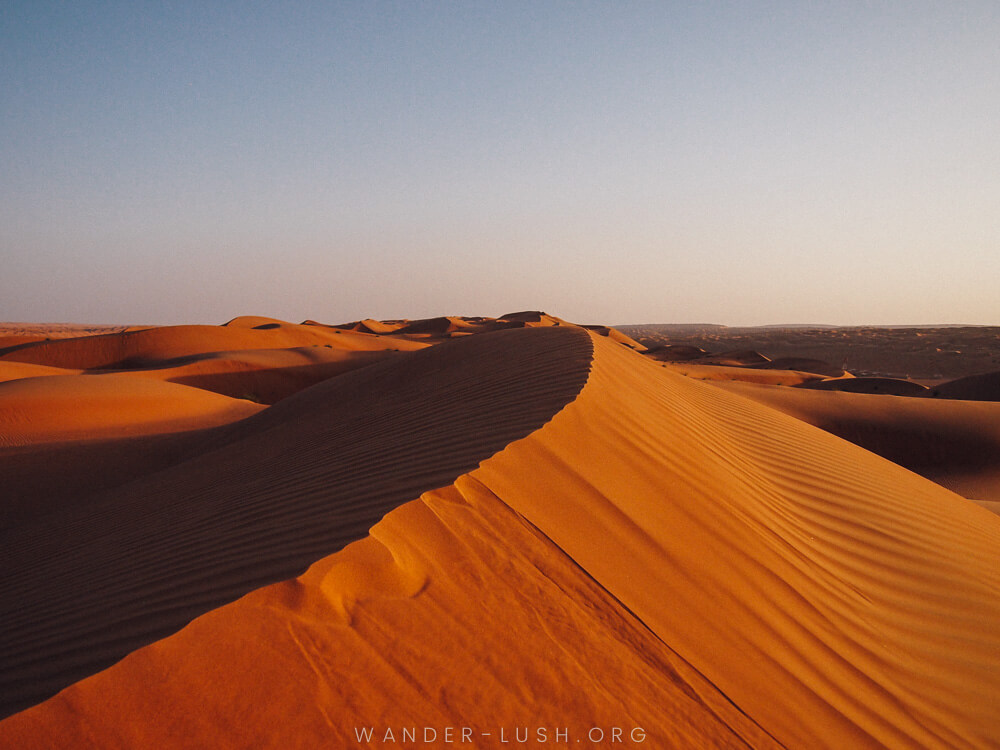
Spending some time in Oman’s Empty Quarter is a must-do for anyone who wants to feel the pulse of the region’s traditional Bedouin culture. Oman holds the sands of four deserts within its borders – the most famous being the Rub Al Khali or Empty Quarter, one of the largest deserts on Earth and one of our planet’s natural wonders.
The Sharqiya Sands (formerly known as the Wahiba Sands) dominates Oman’s inner-north. As one of the most popular tourist places in Oman, it’s the perfect place to spend a day sand dune bashing before watching the sun sink into the undulating, golden waves.
Overnighting at a desert camp is one of the best things to do in Oman. Whether you choose a luxury tent or a more rustic camp, falling asleep under the stars and waking up in the still of the desert is an experience you won’t soon forget.
Get there: 2-hour drive from Muscat.
Where to stay: Desert Nights Camp.
Guided option: Sunset tour with lunch from Muscat.
3. Muscat, Oman’s vibrant capital city

An obvious choice for any visitor, Muscat, the capital of Oman, is the main entry point to this desert nation. With the mighty Al Hajar mountain range on one side and the shimmering Gulf of Oman on the other, the landscape could easily have dwarfed the city. But Muscat is charming in its own way and can certainly be counted among the most beautiful places in the country.
Much of Muscat’s beauty is in the details, from the stunning mosaics and wood inlays in the prayer hall at the Sultan Qaboos Grand Mosque (Oman’s largest and the only mosque that’s open to non-Muslims), to the spice and henna stores inside Muttrah Souq and the vibrant fish market in Muttrah. There’s beauty in the everyday rituals of strolling along the corniche or playing football on the beach at dusk. Mere mention of the name Muscat is enough to send your imagination running wild.
The capital’s world-class museums and galleries offer a perfect introduction to Omani history and culture, priming you for the rest of the country. The traditional Islamic architecture is incredible; even popular tourist attractions such as the Royal Opera House inspire awe with their scale and grandeur.
I recommend spending at least two full days in Muscat.
Get there: Fly into Muscat International Airport.
Where to stay: Royal Tulip Muscat.
Further reading: The best tours in Muscat for culture, history and food.
4. Musandam Fjords, the ‘Norway of Arabia’
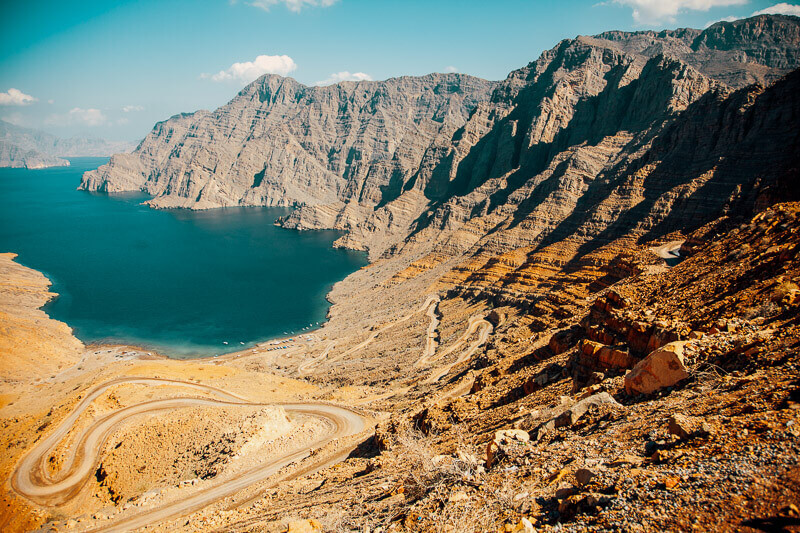
Aptly nicknamed the ‘Norway of Arabia’, the Musandam Peninsula is a landscape that’s reminiscent of the Nordics, largely thanks to the umpteen magnificent fjords that ripple and fold across the Omani coast.
The Musandam Governorate is an enclave enveloped by the United Arab Emirates. To get there, you can drive from Muscat or Dubai, or fly into Khasab Airport. The best way to explore the landscape is on a dhow cruise, while you should also budget time to swim in the cerulean waters of Khasab Beach and Dibba Beach.
The peninsula is quite remote and rugged, with plenty of opportunities for outdoor adventure. Top activities here include dhow rides, scuba diving, snorkelling and dolphin watching. Don’t miss visiting Khasab Fortress or Telegraph Island just off the coast. The perfect spot for history lovers, Telegraph Island was once a British outpost and still has relics of a war-time wireless system.
Get there: 1-hour flight from Muscat or 4-hour drive from Abu Dhabi.
Where to stay: Shams Musandam Motel (Khasab).
5. Al Daymaniyat Islands, an underwater paradise near Muscat

Just off the coast from Oman’s capital city, the Al Daymaniyat Islands (Ad Dimaniyat Islands) can be visited by boat as part of a full day tour from Muscat. A Protected Reserve, there are nine islands in the archipelago surrounded by brilliant blue waters and beautiful corals. This is one of the best places in Oman for scuba diving and snorkelling.
The islands are a valuable nesting ground for sea turtles and migratory birds, making this a sought-after destination for wildlife lovers and birders as well. If you’re here to relax, take a boat out to one of the more remote islands to discover secluded and beautiful beaches.
Entrance to the Al Daymaniyat Islands costs 3 OMR/day for non-Omanis. Prior permission is required from the Ministry of MECA, and this can be organised through a tour agency. If a day trip from Muscat isn’t enough, visitors are permitted to camp on the large islands for up to 5 days for a fee of 10 OMR/night.
Get there: Full-day boat tour from Muscat.
6. Nizwa, Oman’s cultural heartland
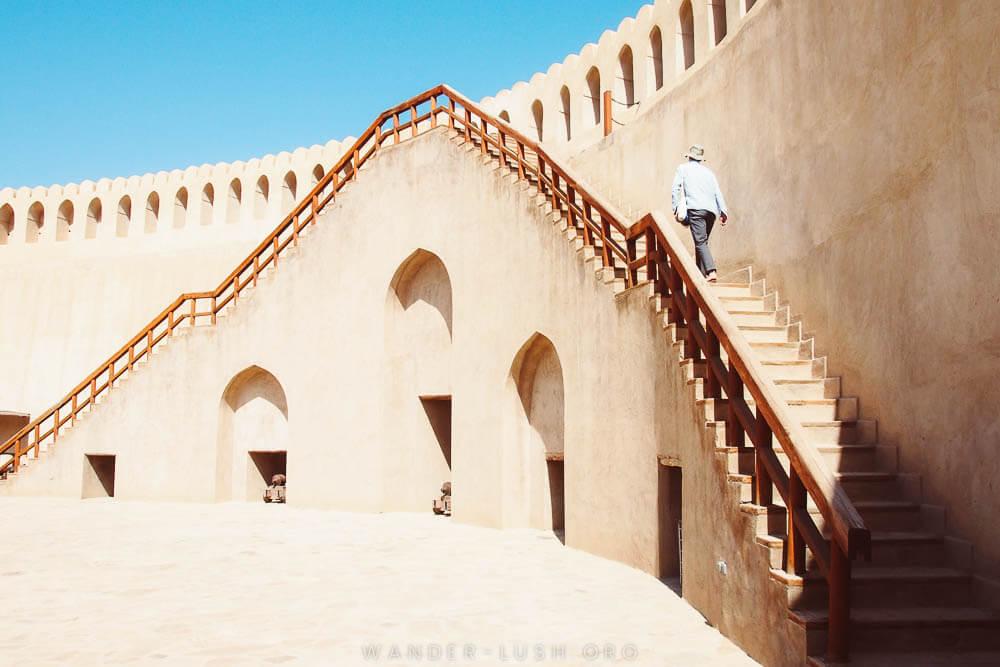
Oman’s second-largest city, Nizwa, is also a must-visit. In the 6th and 7th centuries, Nizwa served as the nation’s capital and blossomed as a centre for the arts and an important nexus on Oman’s main trade route.
Separated from Muscat and the coast by the mountains, Nizwa is an ancient city surrounded by palm groves. Because of its inland location, it has a very different feel to the capital – but there are of course some similarities: Nizwa even has its own Sultan Qaboos Grand Mosque.
Nizwa’s main attraction is the 17th century Nizwa Fort, a massive sand-coloured complex of towers, stairwells, flat roofs, underground passageways and hidden chambers. In the belly of the fortress you’ll find a terrific museum, while the adjoining Nizwa Souq is a shopper’s paradise, famed for its silversmiths and Friday morning goat market.
You can see the best of the city, including Nizwa Fort, in a day. With more time, you can explore more of the ancient forts in the area, including nearby Jabrin Fort (Jibreen Castle) and Samail Fort, located on the road from Muscat. Nizwa is an ideal base for exploring the Al Hajar mountains.
Get there: 2-hour drive from Muscat.
Where to stay: Nizwa Heritage Inn.
Guided option: Historic Nizwa day trip from Muscat with audio guide.
Further reading: My guide to Nizwa Souq and souvenir shopping in Oman.
7. Bimmah Sinkhole, an otherworldly swimming pool

The perfect place to quench your thirst and cool off on a hot day, Bimmah Sinkhole is one of the most popular day trips from Muscat, a darling of Oman tourism – and absolutely one of the most beautiful spots in the country. Its location is just off the coastal highway, 1.5 hours south of Muscat, making it a perfect pit stop as you drive down the coast.
Known locally as Hawiyyat Najm, the sinkhole is a natural depression with a lake at the bottom (300 feet at its deepest point). It was created when the limestone naturally eroded and collapsed in on itself – but an Omani legend says the sinkhole was formed by a meteorite.
The park surrounding the sinkhole is free to enter and opens daily at 8am. The water is safe for swimming; even if you arrive early enough to have the pool all to yourself, you’ll no doubt feel the presence of tiny fish who like to nibble your toes!
If you’re lucky, you’ll see local teenagers come to test their mettle by jumping feet-first from the lip of the Bimmah Sinkhole.
Get there: 1.5-hour drive from Muscat.
Guided option: Wadi Shab & Bimmah Sinkhole day trip from Muscat.
8. Wadi Shab, the ultimate desert oasis

Located on Oman’s coast, the spectacular Wadi Shab (AKA Wadi Tiwi) is more remote than Wadi Bani Khalid but worth the extra bit of time and effort to get to. If you’re driving, pop ‘Wadi Shab Parking’ into Google Maps – this is where you leave your car. From there, it’s a short boat ride costing 1 OMD per person to access the swimming area.
A short uphill hike along the canyon wall to reach the turquoise pools. You can go as deep into the canyon as you like, either by scrambling over the boulders or by jumping into the first pool and swimming up.
The canyon walls contract then widen, creating natural pools and underwater slippery slides on the rocks. If you’re feeling brave, squeeze through the tiny opening in the rocks to find the ‘hidden’ Wadi Shab Waterfall, a beautiful cascade.
Get there: 2.5-hour drive from Muscat.
Guided option: Wadi Shab & Bimmah Sinkhole day trip from Muscat.
9. Misfat al Abryeen, a traditional mud village

Misfat al Abryeen (Misfah al Abriyyin) is a place where Oman’s natural beauty and cultural elegance blend together seamlessly.
Located on the south-western side of the Al Hajar mountains, this is a traditional Omani village with a very unique kind of architecture: All the houses here are constructed from mud and built atop massive stone boulders. This gives the tiny village a very interesting profile and creates lots of nooks and crannies to explore. No cars are allowed – there’s simply not enough room in the narrow laneways.
Driving everywhere in Oman does get tiring. This is a great place to pause for a few days, lock the car and explore on foot. The village is captivating, especially the irrigation system of elevated water channels and outdoor baths that feeds the thick groves of palms, heavy with golden dates. There are marked trails around the village, or else you can simply wander off and see where your nose takes you.
In the evening, you can enjoy a traditional home-cooked meal before settling in for the night at Misfah Old House.
Get there: 2.5-hour drive from Muscat.
Where to stay: Misfah Old House, an incredibly atmospheric guest house located inside an ancestral mud home.
Further reading: My experience of visiting Misfat Al Abriyeen.
10. Jebel Shams & Al Nakhur, Oman’s Grand Canyon
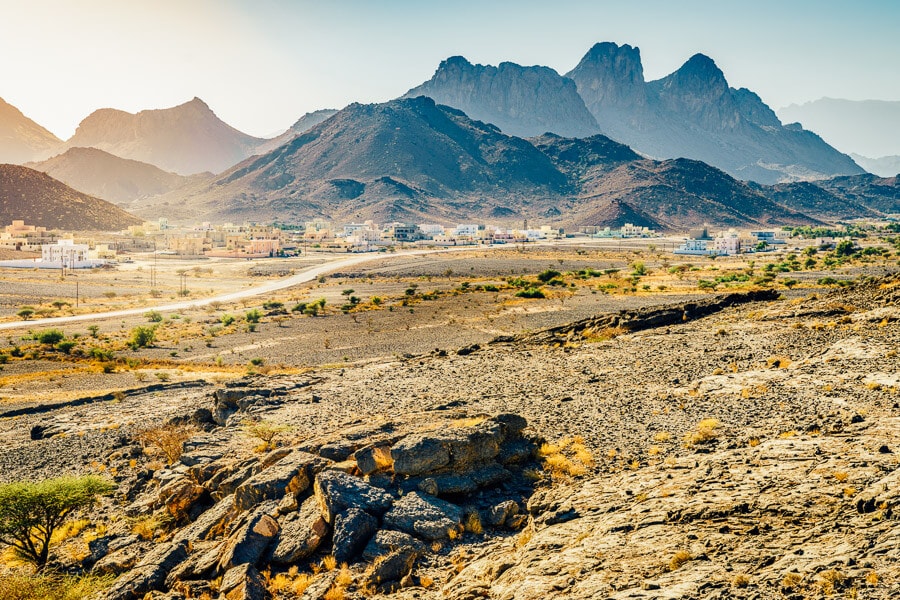
The highest peak in Oman’s Al Hajar range, Jebel Shams mountain is a popular place for hiking, especially in the summer months when the temperature sits at an average 20 degrees Celsius.
The W6 Balcony Walk Hike is the most well-known route, leading intrepid visitors along sheer cliffs to the abandoned village of As Sab. The hike takes a couple of hours to complete and is accessible for anyone with a reasonable level of fitness. Though the views are perilous, the path is wide and safe. You’ll need a 4×4 vehicle to access the trailhead.
Other more accessible paths lead to hidden lakes and mud villages around Wadi Ghul. There are various other viewpoints plus campgrounds and hotels around the village of Al Hayl.
The undisputed highlight of the Jebel Shams area is the spectacular Jebel Shams Canyon or Al Nakhur Canyon. Known as the ‘Grand Canyon of the Middle East’, the oval-shaped canyon is only 8km long, but reaches depths of up to a kilometre at some points.
Get there: 4-hour drive from Muscat (or 2-hour drive from Nizwa).
Where to stay: Canyon Rest House (near Wadi Nakhr) or Misfah Old House (Al Hamra).
Guided option: Al Hajar tour from Muscat with Nizwa and Jebel Shams.
11. Jebel Akhdar, the ‘Green Mountain’

Also part of the Al Hajar range, Jebel Akhdar or the ‘Green Mountain’ is located south-east of Jebel Shams. Known for its wet climate and fertile soil, it’s a complete contrast to the rocky profile of Al Nakhur: Terraced gardens and dense shrubs give Jebel Akhdar the appearance of a glimmering emerald in a desert sea.
The Saiq Plateau is one of the most fertile places in Oman. Once only accessible by donkey, it’s overgrown with peach, pomegranate, apricot and lemon trees. Hiking trails around Wadi Bani Habib lead to yet more ancient mud villages and picture-perfect vistas.
While in the area, be sure to drive through the Sumail Gap, a natural pass that denotes the split between the Eastern and Western Hajar Mountains.
Get there: 4-hour drive from Muscat (or 2-hour drive from Nizwa).
Where to stay: Shorfet Al Alamin Hotel (Al Hamra).
Guided option: Full-day Al Hajar tour from Muscat visiting Jebel Akhdar and small villages.
12. Bald Sayt, a picturesque mountain village
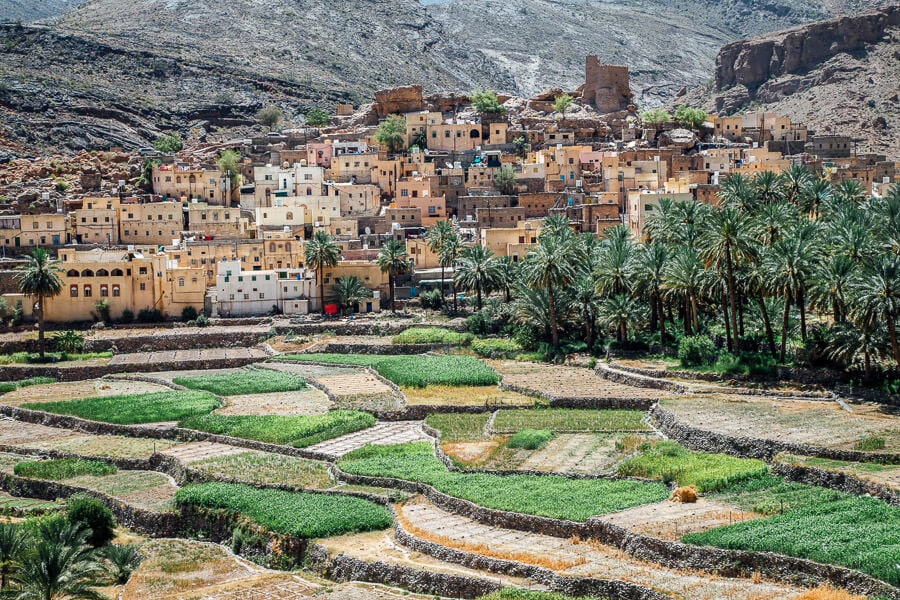
When it comes to beautiful Omani villages, Bald Sayt takes the cake. One of the most spectacular places in the Middle East, Bald Sayt is nestled deep in the Al Hajar mountains in the shadow of Jebel Shams. As with nearby Jebel Akhdar, it’s all verdant green mountains and beautiful terraces cultivated to support fruit trees, date palms and other crops.
Like other ancient villages in the area, Bald Sayt is extremely remote and was cut-off from the rest of Oman for most of its history, only accessible by donkey trail. Even today, it’s only reserved for the most adventurous tourist as it requires a 4×4 (and an experienced driver) or a long canyon hike to get there.
Follow marked paths around the farming village to get views of the vernacular architecture framed by palm plantations and lush greenery. There are no guesthouses or restaurants in town so if you’re visiting independently, make sure you come prepared with enough water and supplies.
Get there: 2.5-hour drive from Muscat (off-road vehicle required).
Where to stay: Shorfet Al Alamin Hotel (Al Hamra).
13. Sur, the spiritual home of Sinbad the Sailor
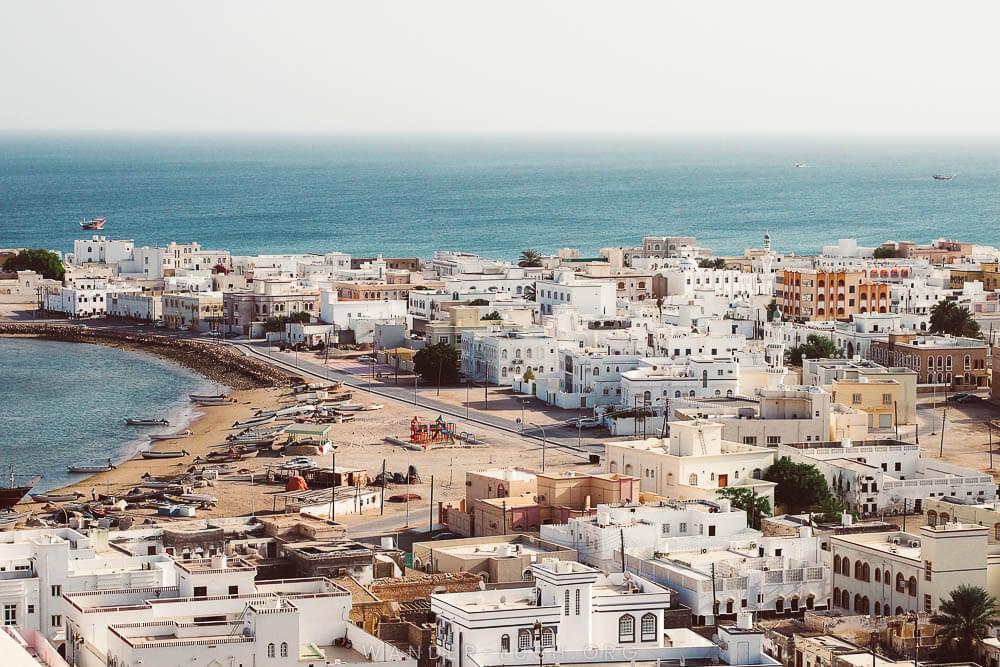
Sur is a small port city 200km from Muscat that many tourists skip through on their way to Ras Al Jinz. The coastal architecture and laid-back vibe makes it one of my favourite places in Oman.
Sur city is a sea of lily white houses. When paired with the iridescent waters of the city’s natural harbour and the brick-coloured rock formations around the coast, it’s an absolute visual delight. There isn’t a whole lot to do in Sur, but it’s lovely just walking along the harbour and admiring the wooden dhows. There’s even a dhow factory where you can see artisans crafting these magnificent boats according to traditional methods (no nails, no glue!).
For a great view of the city and the dhows, climb up Al Ayjah Watch Tower. There is a smattering of lighthouses, castles and of course mosques around the city that you can also visit, including the impressive rose-tinted Bilad Sur Castle. It’s equally pleasurable just wandering the lanes around Makha and Ar Rashah and admiring the painted gates.
Get there: 2-hour drive from Muscat.
Where to stay: Turtle Guest House.
14. Ras Al Jinz Turtle Reserve, one of the best places to visit in Oman for wildlife
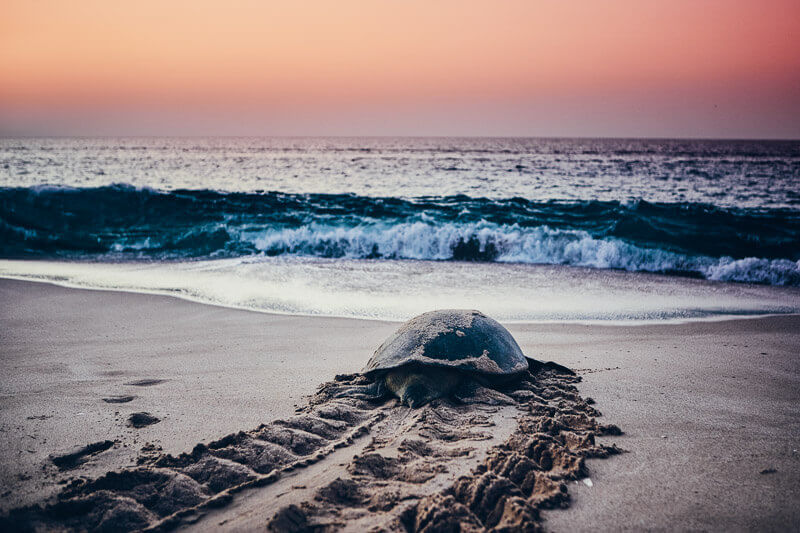
Sitting at the easternmost tip of the Arabian Peninsula, Ras Al Jinz is a small fishing village. The beaches here are world-famous as one of the most important nesting grounds for the endangered green turtle.
In 1996, the Sultan of Oman established the Ras Al Jinz Turtle Centre to safeguard the nesting grounds and promote ecotourism in the area. The only way to visit the beach is by joining one of the guided tours that depart every night from the Centre.
This is one of the few places on earth where turtles are known to lay 365 days a year. Your chances of seeing both adult females laying eggs and hatchlings making a break for the surf are almost guaranteed. Witnessing one is tremendous – but let me tell you, seeing both within the space of an hour is nothing short of incredible.
Get there: 45-minute drive from Sur.
Where to stay: Ras Al Jinz Turtle Reserve.
15. Bahla Fort, a UNESCO World Heritage Site

One of the best-protected military forts in Central Oman, this 13th century UNESCO World Heritage Site (one of the country’s five inscribed properties) is a perfect example of authentic architecture. Visitors have access to the fully restored ramparts and passages which give you an insight into the history of the Banu Nebhan tribe who built this impressive defensive structure and the surrounding vernacular houses.
Bahla Fortress sits at the foot of the Jebel Akhdar highlands roughly halfway between Nizwa and Misfat Al Abriyeen. It’s well worth stopping off for a short walk around the fort and through the rows of mud houses on your way through.
Alternatively, make a day of it by driving the Rustaq Loop and visiting Rustaq Fort and Al Awabi Fort at the same time. You can start and end this historic circuit drive from Barka, just north along the coast from Muscat.
Get there: 40-minute drive from Nizwa.
16. Masirah Island, a dhow boat graveyard
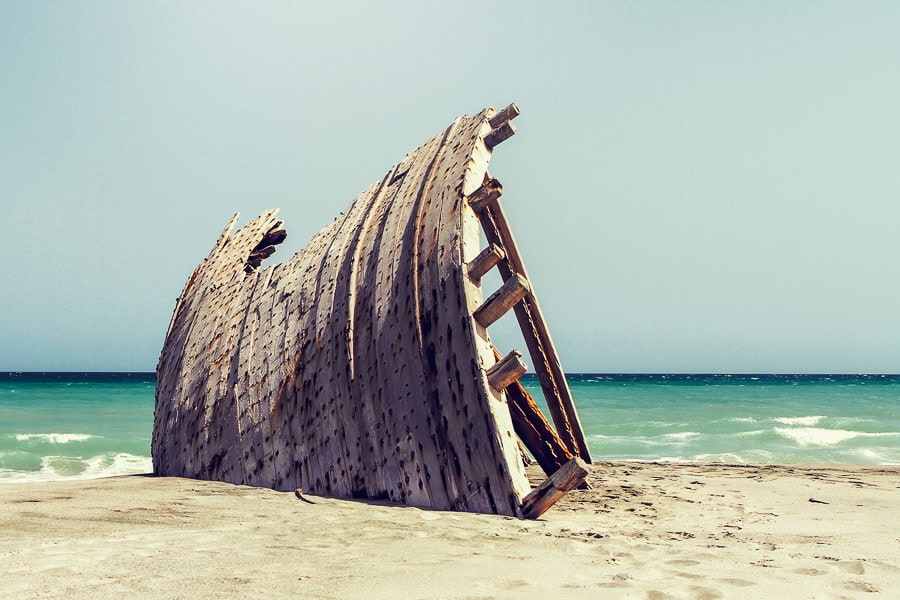
Oman’s largest island, Masirah Island sits in the Arabian Sea off the country’s north-east coast. Daily ferries run from Shannah Port, around a four-hour drive from Sur.
An off-the-beaten-track destination in the truest sense of the term, Masirah is rugged and remote. The sandy beaches may be gorgeous, but watch out for the unforgiving current that toss boats about at their will.
Dozens and dozens of wrecked wooden dhows sit like beached whales up and down the shore – a testament to the ferociousness of these waters. Salt water and intense heat have preserved their structures, turning the wrecks into a playground for photographers and urbexers.
Get there: 1.5-hour ferry ride from Shannah Port.
Where to stay: Masirah Beach Camp.
17. Salalah, Oman’s green paradise

Located at the opposite end of the country to Musandam, some 1,300 km south of the peninsular or 1,000 km from Muscat, Salalah has a totally distinct climate and topography to the north-eastern part of Oman.
Tropical banana plantations and a monsoonal climate have led many to compare Salalah with Kerala in South India. If Oman’s desert interior is stark, then Salalah is the land of plenty. It’s the epicentre of the country’s revered frankincense industry – something you can learn about at the Frankincense Land Museum in Salalah city.
Venture west along the coast to discover pristine beaches and rugged coastline. Mughsail Beach, with its ocean blowhole, is beyond stunning. To the east, the historic town of Taqah is home to more sandy beaches and the restored Taqah Castle, with a museum dedicated to Darfour region inside.
Green Wadi Darbat and pockets of baobab tree forest lie inland from Taqah and are the perfect setting for outdoor adventures. If the sea is calling, there is a collection of beach resorts along the coast, with the most popular being around Salalah city,
If you don’t want to brave the 10-hour desert drive from Muscat, you can fly into Salalah’s international airport instead.
Get there: 1.5-hour flight (or 10-hour drive) from Muscat.
Where to stay: Al Baleed Resort Salalah by Anantara.
Plan your visit to Oman
Is Oman your next travel destination? If you were on the fence before, I hope this round-up of the most beautiful places in Oman has nudged you in the right direction!
If you are planning a trip, here are the resources I used to plan my own travels around Oman. These should come in handy for planning your route and preparing all the logistics.
– As of February 2019, Oman no longer issues visa on arrival. Use iVisa to check if you need a tourist e-visa for Oman and apply for an expedited visa online.
– Pre-book a private transfer from Muscat Airport to your hotel.
– Find the best hotel deals in Oman on Booking.com or Agoda.
– Find the best city tours and day excursions in Oman. Check out my round-up of the best Muscat day tours for more inspiration.
– Search and compare car rentals using Discover Cars to find the best value for money.
– No car? Book a hop-on hop-off bus tour of Muscat or charter a car and driver instead.
– Limited time? This 4-day tour of Oman covers all the highlights.
– Pick up a copy of the 2019 Lonely Planet guidebook for Oman.
5 things to pack for Oman
- An anti-theft backpack. As a general rule, Oman is a very safe place and petty crime against tourists isn’t really an issue. Still, a good anti-theft day pack is worth having to keep your valuables safe in the city. If you’re having trouble deciding, here are a few of my favourite minimalist backpack designs.
- A scarf for visiting mosques (women). A lightweight cotton scarf is my number one travel item. In Oman, it will come in extra handy for covering your hair when entering a mosque or for draping over your shoulders when visiting a market or a rural area. This neutral travel scarf goes with anything, and it even has a hidden pocket.
- Walking shoes. Comfy walking shoes are absolutely essential for Oman. I love these ones for women, while my partner lives in these waterproof shoes.
- A reusable water bottle. Avoid single-use plastics whenever you can. I love my S’Well water bottle for warm climates because it doesn’t sweat. Silicone bags, a reusable straw and a portable cutlery set might also come in handy in Oman.
- An Oman guidebook. I recommend the 2019 Lonely Planet guidebook for Oman.